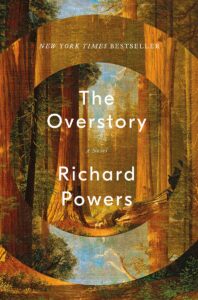Celebrating the Birthday of the Universe
September 2, 2018 in Library Corner
By Robin Jacobson.
“I speak for the trees, for the trees have no tongues.”
–The Lorax by Dr. Seuss
According to tradition, Rosh Hashanah is the birthday celebration of Creation. In one rabbinic tale, God takes Adam on a tour of the Garden of Eden, proudly pointing out its natural splendors and admonishing, “Do not destroy my world…for there is no one after you to repair it.” Alas, as studies of pollution and climate change overwhelmingly show, humans have not been the best stewards. Award-winning author Richard Powers hopes to move us to better care for the Earth, if only to save ourselves from extinction. His latest novel, The Overstory, aims to deepen readers’ appreciation for some familiar, beloved denizens of the natural world – trees. Critics laud Overstory as a “Great American Eco-Novel” and a “sylvan tour de force,” a novel that “remakes the landscape of environmental fiction.”
An Environmental Epic
 Overstory is an ambitious work, structured like a tree into sections labeled “Roots”, “Trunk”, “Crown”, and “Seeds.” The “Roots” section introduces nine very different American characters who have each had a profound experience involving a tree. Five of the characters will later meet as radical environmentalists trying to save the last tracts of America’s old-growth forests in the Pacific Northwest in the 1990s.
Overstory is an ambitious work, structured like a tree into sections labeled “Roots”, “Trunk”, “Crown”, and “Seeds.” The “Roots” section introduces nine very different American characters who have each had a profound experience involving a tree. Five of the characters will later meet as radical environmentalists trying to save the last tracts of America’s old-growth forests in the Pacific Northwest in the 1990s.
Artist Nicholas Hoel is the sole survivor of an Iowan farm tragedy, the inheritor of a cherished family chestnut tree and hundreds of photographs taken by generations of Hoels recording its growth. Engineer Mimi Ma confronts a tragic death under a mulberry tree planted by her Chinese immigrant father. Douglas Pavlicek, a Vietnam War soldier, is saved from death when he falls from his flaming plane into the branches of a banyan tree. Patricia Westerford, who is partially deaf, studies trees with her father and grows up to be a dendrologist, initially mocked by other scientists for path-breaking research showing that trees communicate. Other characters include a paraplegic computer game pioneer, an intellectual property lawyer, and a psychologist who studies human blindness to catastrophes that unfold gradually (like climate change).
The Science of Trees
Overstory is a paean to trees – wondrous life forms that are among the largest and longest-lived on Earth. Two characters camp for nearly a year 200 feet above ground in a giant redwood (they are trying to save it from being cut down), and Powers writes lyrically of their growing awareness of the spectacularly rich complexity of forest life.
Overstory is informed by scientific studies showing, incredibly, that trees communicate with each other both through the air and underground. For example, when a giraffe starts chewing acacia leaves, the tree emits a “distress signal” in the form of ethylene gas. Neighboring acacia trees start pumping toxins into their leaves that sicken giraffes. Below ground, trees send each other water, carbon, and nutrients appropriate to each tree’s needs through a vast network of fungal threads buried in the soil.
Why did Powers choose to join science with art to create a novel? He could have written a work of non-fiction extolling the contributions of trees to the Earth’s well-being, warning of the perils of deforestation, and urging readers to become environmental activists. One of Overstory’s characters suggests an answer. Psychologist Adam Appich tells eco-activists, “The best arguments in the world won’t change a person’s mind. The only thing that can do that is a good story.” For Rosh Hashanah, a holiday celebrating Creation, Overstory is an especially relevant read, a reminder that humanity is only one part of Creation.